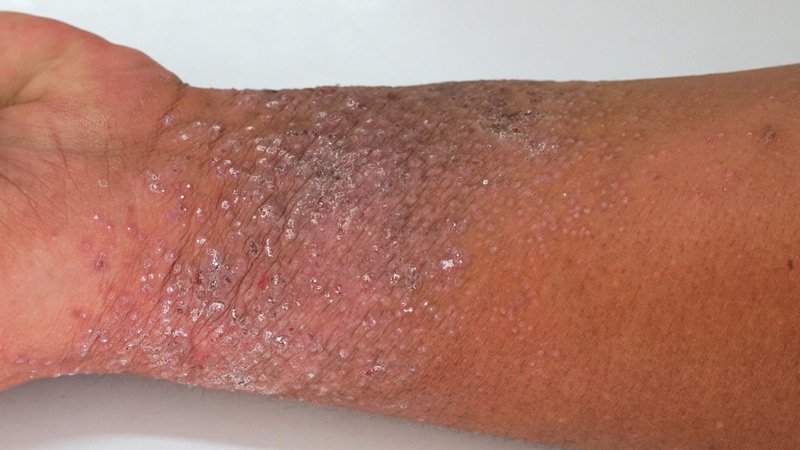ATOPIC DERMATITIS

Definition: An inflammatory, chronically relapsing, non-contagious and pruritic (itching) skin disease.[1]
Other Names: prurigo Besnier, neurodermitis, endogenous eczema, flexural eczema, infantile eczema, and prurigo diathsique.[2]
Symptoms
The skin of a patient with atopic dermatitis reacts abnormally and easily to irritants, food, and environmental allergens. Skin becomes red, flaky and very itchy. The skin on the flexural surfaces of the joints (Ex. inner sides of elbows and knees) is the most commonly affected region. Atopic dermatitis often occurs together with other atopic (allergic hypersensitivity) diseases like hay fever, asthma and conjunctivitis. It often runs in families and is a chronic (lifelong) disease. Its symptoms can increase or disappear over time.
Causes
There is no certain cause of atopic dermatitis. However, it is speculated that allergens and biological factors play a role in the disease.
1. Allergy
Although it is an inherited disease, eczema (of which atopic dermatitis is at specific type) is primarily aggravated by contact with or intake of allergens, but can be influenced by other factors that affect the immune system such as stress or fatigue. [3]
2. Biological
It is known that atopic dermatitis does run in families, however the changing frequency of the disease over time points to the environmental factors (for example nutrition or hygiene) that also play a role in disease susceptibility.
In a publication in Nature Genetics from April 6, 2009, Young-Ae Lee of the Max Delbrück Center for Molecular Medicine in Berlin and her colleagues report a strong association between atopic dermatitis and a common genetic variant, a new locus on chromosome 11, potentially associated with the gene C11orf30. [4]
Prevention
Since there is no cure for atopic eczema, treatment should mainly involve discovering the triggers of allergic reactions and learning to avoid them. An allergy skin-patch or “scratch” test, given by an allergist, can often pinpoint the triggers of allergic reactions.
Diet: Originally controversial, the association of food allergy with atopic dermatitis has now been clearly demonstrated. Many common food allergens can trigger an allergic reaction: such as milk, nuts, cheese, tomatoes, wheat, yeast, soy, and corn.
Environment and Lifestyle: Since dust is a very common allergen and irritant, adults with atopic eczema should likely avoid smoking, as well as the inhalation of dust and pet dander because these may trigger an inflammatory response. Anger, stress, and lack of sleep are also factors that are known to aggravate eczema. Excessive heat (especially with humidity) and coldness are known to provoke outbreaks; as well as sudden and extreme temperature swings.
Treatment
The primary treatment involves prevention, includes avoiding or minimizing contact with (or intake of) known allergens. Topical treatments focus on reducing both the dryness and inflammation of the skin. To combat the severe dryness associated with atopic dermatitis, a dermatologist approved moisturizer should be used daily. Moisturizers are especially effective if applied within 5–10 minutes after bathing. A non-drying soap or soap substitute such as aqueous cream can help keep the skin moisturized. For more severe eczema, a doctor may prescribe topical corticosteroid ointment (ointment containing steroids), creams, or steroid injections. Always consult a doctor before beginning to use a steroid.
A more novel form of treatment involves exposure to broad or narrow-band ultraviolet light. However, UV radiation has also been implicated in various types of skin cancer and thus UV treatment is not without risk.
In severe cases that do not respond to other treatments, oral immunosuppressant medications are sometimes prescribed, such as ciclosporin, azothioprine and methotrexate, however these treatments require patients to take regular blood tests as they can have significant side effects on the kidneys and liver. [5]
References
- De Benedetto A et al. Atopic dermatitis: a disease caused by innate immune defects? J Invest Dermatol. 2009;129:14-30.
- Abels C, Proksch E. Therapy of atopic dermatitis. Hautarzt. 2006;57:711-23.
- lüken H, Wienker T, Bieber T (2003). “Atopic eczema/dermatitis syndrome – a genetically complex disease. New advances in discovering the genetic contribution”. Allergy 58 (1): 5–12.
- Esparza-Gordillo; Weidinger, S; Fölster-Holst, R; Bauerfeind, A; Ruschendorf, F; Patone, G; Rohde, K; Marenholz, I et al. (2009). “A common variant on chromosome 11q13 is associated with atopic dermatitis.”. Nature Genetics. 41 (5): 596–601.
- Wooltorton E (2005). “Eczema drugs tacrolimus (Protopic) and pimecrolimus (Elidel): cancer concerns.”. CMAJ 172 (9): 1179–80.


